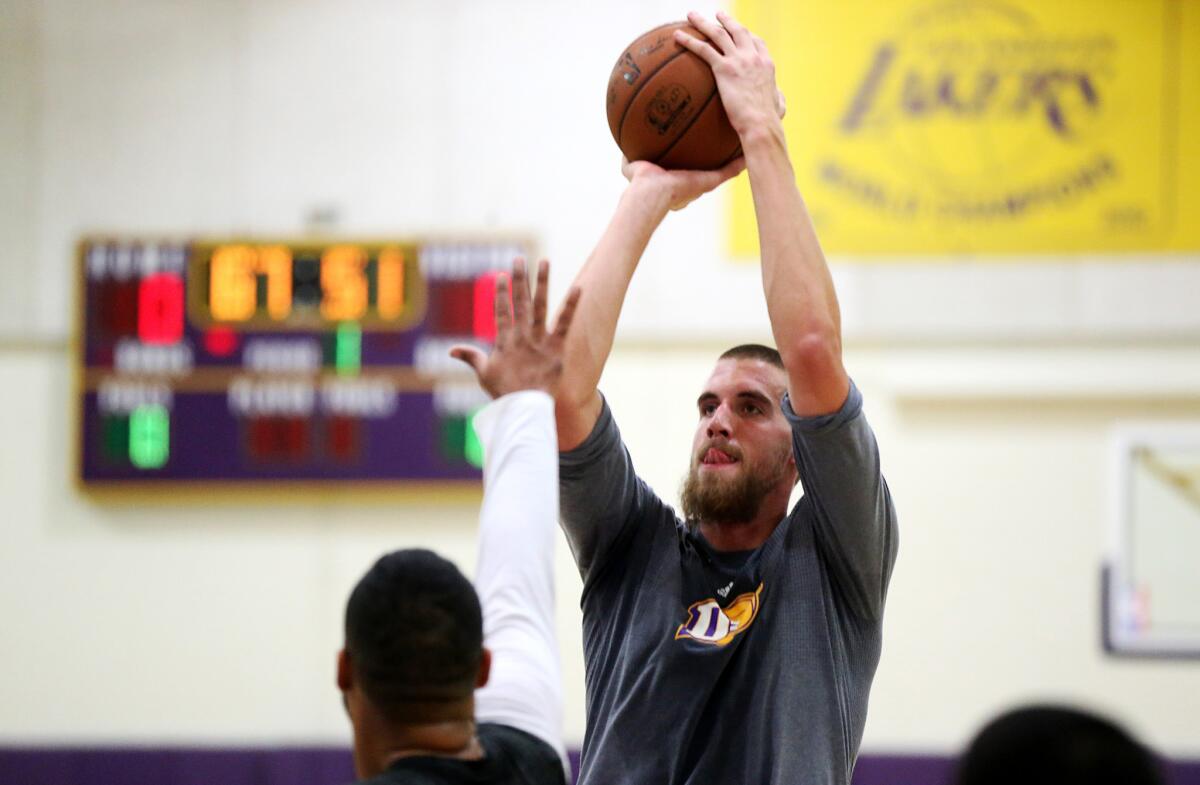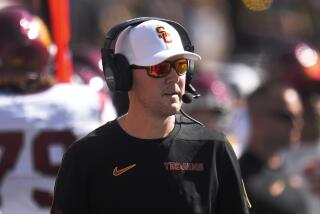In the D-League, long shots keep hoping for a chance to play in the NBA

David Foster, a 7-foot-3 center, can fit inside a Mini Cooper. Trust him on this.
He knows every one of the few cars he can comfortably drive. He sat in the new Audi A8 L at an auto show in November, his two young boys crawled over the leather seats and he and his wife pictured a bigger family inside the spacious vehicle.
But they aren’t shopping for new cars. Instead, they share a Hyundai Sonata they call their “commuter car,” good on miles and perfect for a basketball career that could end any moment.
Foster, 28, is a rim-protecting center for the Los Angeles D-Fenders, the Lakers’ NBA Development League affiliate. He wasn’t drafted out of Utah, has never played in the NBA and is hoping his last-ditch effort to get there does not sputter out.
The D-Fenders are one of 22 D-League teams and they play their home games at Toyota Sports Center, the Lakers’ practice facility in El Segundo. The D-Fenders draw about 150 mild-mannered fans — the gym’s maximum occupancy is only 993 and it seats 508— who pay $25 to sit in one of six rows of chairs.
Fans must enter through the L.A. Kings’ practice rink, and snake down a stairwell that smells like sweaty hockey gear. When the D-Fenders play there is normally a single food truck outside and on-court entertainment during timeouts and quarter breaks. The ice rink pushes cool air through a propped-open door and the basketball gym chills as the games heat up.
Those in the D-League, where annual salaries are set at either $26,000 or $19,500, can be loosely broken into three categories. There are recent draft picks who will likely get an NBA chance. There are players who had a chance and are clawing for another. And then there are those who were undrafted, unheralded and under no guarantee they will ever reach the next level.
That last category is where Foster fits. He had back-to-back foot surgeries to end his college career, a short stint playing in the Middle East and was a substitute teacher before the game started calling him back. It is a distinct path to the fringe of professional basketball, but in the D-League there’s lots of hope to go around.
“Everyone in the D-League is looking to get called up,” Foster said. “If you’re a player, coach, referee, I mean you’re looking for an opportunity to play in the big league. You’re looking for that one shot.”
His dad, Lee Foster, a data-crazed engineer, annually charted the heights of his nine children on a closet frame. David, the second oldest, started with a growth spurt that never seemed to stop. The marks on the door jamb kept climbing and climbing and David eventually outgrew the closet altogether.
The Fosters moved to California when David was 13. Lee moved the height chart to the garage.
“There comes a point where basketball just chooses you,” Lee said. “Everyone just keeps asking you what team you play for, and eventually you just put your mind to the sport.”
Foster enrolled at Utah as a mountain of raw potential. He averaged four blocks per game as a sophomore and was named Mountain West Conference defensive player of the year. His junior season was similar — limited offense, endless blocks — and NBA scouts expressed interest ahead of his senior year.
But then he felt pain in his right foot during a preseason exhibition.
He thought it was just tendonitis. An X-ray showed nothing out of the ordinary, an MRI came back negative, but then a CT scan revealed a stress fracture that would sideline him for the season. The NBA scouts vanished. Foster was determined to return as a redshirt senior.
That lined up until the pain came back during a suicide sprint before the next season. This time Foster knew it right away: another surgery, another yearlong rehab, another reason to hang it up altogether.
“His heart, his head were in the perfect place, you know, the kind of kid you want to coach,” said Utah Coach Larry Krystkowiak. “And he just had a body that wasn’t cooperative.”
Foster rehabbed with a Utah assistant every morning, and made money by teaching workout classes to the elderly in the afternoon. He received an offer from a team in Qatar and flew there in February 2014. But he missed home, FaceTimed with his wife Britta every night and wrote in a journal that his basketball career was over.
After two weeks he boarded a flight back to his family.
“It came down to me having to figure out what the heck I’m going to do without basketball,” Foster said.
It turned out to be teaching. Foster started as a substitute at Rosamond High School in a small desert town north of Palmdale. To make ends meet in the summer, he walked door-to-door selling home security systems for a company called Vivint, the name sponsor of the Utah Jazz’s home arena. Then Rosamond hired him as a full-time teacher and he took the job so he could also coach basketball.
That inched him back to the game. First he started thinking about basketball while going through lesson plans. He did push-ups before his students arrived in the morning and ran up the hills behind the school in the afternoon. He then played in a pickup game at Utah and felt comfortable running up and down.
“I knew he couldn’t leave it the way he had,” Lee said. “That’s not David.”
He, Britta, and their two baby boys stayed in a friend’s basement for a month while Foster worked out in Salt Lake City. A one-month showcase in China helped him earn a training camp invite with the Delaware 87ers, the D-League affiliate of the Philadelphia 76ers, but he didn’t make the 2015-16 roster.
Undeterred, in January Foster went to Chihuahua, Mexico, to play for a team on a 3½-month contract. He returned for another summer of training before trying out for the D-Fenders, twice auditioning in the Toyota Sports Center. This time he made the regular-season roster to start his D-League career at 28.
“You figure the window isn’t going to be open forever,” Foster said. “So why not take it while you still can?”
Some days bring confidence, others make it hard to find any hope.
Foster has never been offensive-minded and still focuses on protecting the rim, setting good screens and vacuuming the glass. He had five blocks in 15 minutes on Nov. 19 and made his first and only start on Nov. 29.
But playing time has been hard to come by. The D-Fenders recently signed veteran center Jeff Ayres — who has played 275 NBA games in six seasons — and Lakers’ rookie center Ivica Zubac has also played with the team. Foster was active on Dec. 1 but did not play, and was inactive for a win over the Reno Bighorns a week later.
He stuck around to sign autographs after the Reno game, and a middle-aged woman told him he played great. Foster, in a sweatshirt and jeans, smiled and gave her two thumbs up. The next night he and his wife sat five rows up across from the Lakers’ bench in Staples Center and watched the shorthanded Lakers fall behind the Suns before leaving at halftime.
“He has a family, he has kids, he knows there is a lot at stake here,” Ayres said. “We talk a lot about the ‘why.’ Like why are we playing this game? I think for David that why is pretty clear.”
Some D-League players quit when the money runs dry, others when the ball stops going in. Foster would quit after another major injury. He doesn’t want to impair himself for life. He wants his boys — now 2 and 4 — to have him be a human jungle gym as they grow up. He could go back to teaching, and this time it would feel like on his own terms.
Until then, the D-Fenders provide housing for his family and the Fosters are breaking even. He will keep working out before practice and lifting weights long after it. He will keep going through rolls of medical tape to keep his body intact. He will curl up his long legs for the bus rides and crowded commercial flights.
He will take his sons to the park every game-day morning, shower before putting on his uniform and then play as if he will never wear it again.
“You have to have Plan B and I have one, but you just have to attack each day like there isn’t a backup plan,” Foster said. “This is it. This is all I got.”
jesse.dougherty@latimes.com
More to Read
Go beyond the scoreboard
Get the latest on L.A.'s teams in the daily Sports Report newsletter.
You may occasionally receive promotional content from the Los Angeles Times.










